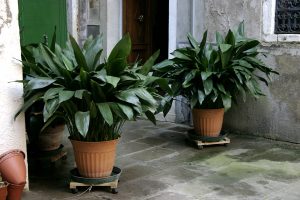
Top Low Light Houseplants
If you have rooms with very low light such as north-facing or windowless rooms, there are options to enliven and naturalize your space with living plants. Here is a list of plants that are troopers for their ease of growing and light needs. To in-crease your chances of success, you can do the following:
Choose plants or varieties that are solid green or with less amounts of variegation.
Consider leaving the lights on for 12 hours a day, or use an LED spotlight with at least 900 lumens.
Occasionally move the plants to an area with more light. But be careful to avoid full sun as the leaves will not be accustomed to this.
Wipe the leaves with a damp cloth or tepid water to remove dust – it interferes with light absorption.
Plants for Low Light
Cast Iron Plant (Aspidistra elatior) – very tolerant of low light conditions and in-consistent watering. Mature height is about 3′.
Chinese Evergreen (Aglaonema commutatum) – choose one with less variegation. Handles dry air but needs moist soil.
Corn Plant (Dracaena fragrans) – Look especially for the variety with the solid green leaf. This plant can take virtually any light exposure, so you don’t need to worry where you place it.
Janet Craig Dracaena (Dracaena deremensis ‘Janet Craig’) – an old low light stand-by for many years. Can reach about 8′ tall eventually. Also survives low humidity and infrequent care.
Kentia Palm (Howea forsteriana) – Give it space to fan out. As a container plant it usually grows to 5-12′ tall.
Lucky Bamboo (Dracaena sanderiana) – can be kept in water (changed weekly) or in evenly moist soil. Often sold woven in interesting patterns.
Monstera/Swiss Cheese Plant (Monstera deliciosa) – can take a wide range of light conditions including low (stronger light allows it to grow faster). It has a climbing habit as it matures so you can either keep it pruned or supply a support. Older leaves can grow to a dramatic 2′ across. Not to be confused with Split-leaf Philodendron, which doesn’t have holes in the leaves and which fares better with more light.
Parlor Palm (Chamaedorea elegans) – although in the long run it would prefer medium light, this palm can tolerate low light for very long periods.
Pothos (Epipremnum aureum) and Heartleaf Philodendron (Philodendron hederaceum) – I list these two together because their appearance and growing conditions are very similar. Pothos varieties can have different variegations to them but if grown in low light they will be green like most Philodendron. The best way to tell them apart is to look at their leafstalks. Pothos have a groove or trough along the stalk whereas Philodendron is smooth/round. Both plants tolerate low light but Pothos with time may become leggy. Pothos is a little more tolerant of sun and drought. Both can climb/trail many feet.
Snake Plant (Sansevieria laurentii) – these come in quite a few shapes and colors from leaves that are sword shaped, short and wide to long and strappy, and even cylindrical. Colors vary from green to green and yellow, with white and even solid gray. Again, the green varieties should do best in low light. Snake plants are also tolerant of dry air and can easily exist on monthly watering.
ZZ Plant (Zamioculcas zamiifolia) – also requires very little water and usually doesn’t exceed about 3′.
